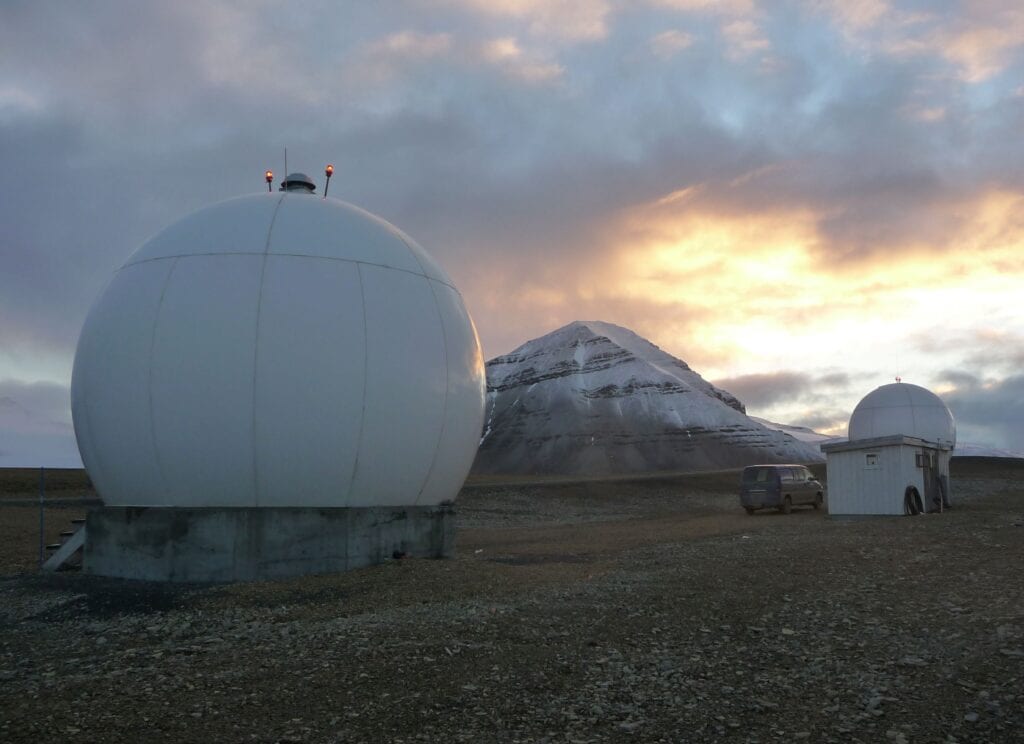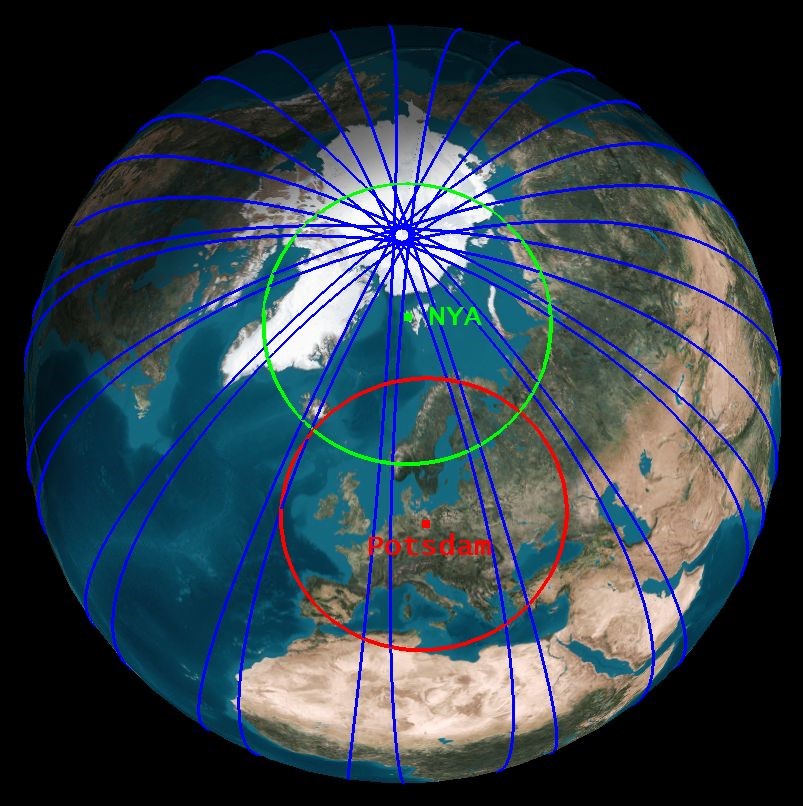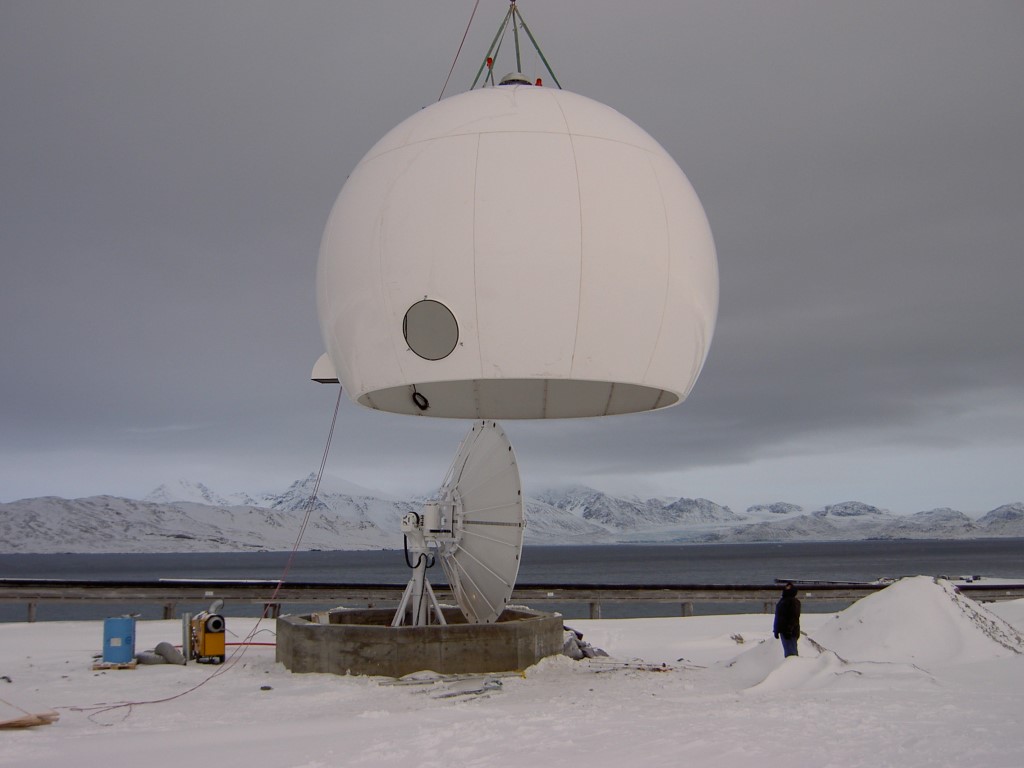Photo: C. Falck, GFZ
20th anniversary of the NYA satellite receiving station in Ny-Ålesund
By Carsten Falck, GFZ
It was in spring 2001 when the satellite receiving station in Ny-Ålesund (abbreviation NYA, photo 1) started to receive CHAMP, a scientific remote sensing satellite with innovative instruments on-board. The required initial local infrastructure was just completed with support from Kings Bay, AWIPEV (French – German Arctic Research Base) and DLR (German space agency). Two decades and many upgrades through GFZ later, this has grown to a remotely controlled multi satellite receiving station with active redundancy for increased reliability.
At the beginning the station had only one antenna, the “CHAMP antenna” and the satellite receiver, which was placed in a new small hut next to the antenna, could receive only CHAMP. The CHAMP mission was managed by the GFZ German Research Centre for Geosciences and all satellite data was completely received in Germany (by DLR) since the launch of CHAMP in 2000. So what was the driver for the significant effort to receive CHAMP additionally in a remote polar region, and why of all places in Ny-Ålesund?

CHAMP was the first satellite that continuously conducted atmospheric sounding with so called GNSS radio occultation measurements (among other). The products of such measurements are comparable to meteorological data from radiosondes, e.g., as launched with balloons in Ny-Ålesund by AWIPEV. The more than 200 globally distributed measurements per day from CHAMP thus had a high potential to improve weather forecasts and climate research. GFZ wanted to foster the new method with scientific studies and an own data processing chain at Potsdam, but also with the continuous provision of CHAMP data to other parties, not later than 3 hours after on-board measurements, as this was the deadline for data assimilation by weather services. Only about 4 contacts per day are possible between satellites in a CHAMP-like orbit and ground stations in Germany (see graphic 1), resulting in a mean data latency of 6 hours (24 hours/4). About 15 contacts per day are possibly with an antenna in Ny-Ålesund, so that the raw data provision latency is only about 96 minutes (24 hours/15). This was fully sufficient to meet the 3 hours criteria of the interested weather services. In consequence they used CHAMP data in their weather forecast processes, first test wise over several years, later as part of their standard routines.
Ny-Ålesund is an excellent location for the receiving station for other reasons also. It has good infrastructures and GFZ already had good contacts to Ny-Ålesund since mid of the nineties, e.g., for seismological and GNSS measurements, and the project PRARE (with Norwegian Mapping Authority). The area of Ny-Ålesund is declared as a radio quit area, so there should be minor risk for interference effects from local radio sources. Even WLAN is not allowed in Ny-Ålesund and rare exceptions for special tasks are expected to avoid transmissions too close to the NYA-antennas or at times when they are especially sensible for disturbances from WLAN. The NYA station itself is a pure receiving station, without any transmitters.
Today GNSS radio occultation instruments are on-board of several satellites and the related data products are used by many weather services and climate research worldwide. The satellite receiving station in Ny-Ålesund made a valuable contribution to this development. However, the CHAMP mission ended in 2010 when the satellite burned in the atmosphere. So what came next?

More scientific satellites to be received in Ny-Ålesund appeared soon. From 2002 to 2006 the satellite BIRD (for detection of forest fires) was received occasionally (for DLR) with a separate receiver. GFZ invested in more versatile receivers (first one installed in 2004), which were capable to receive more satellites, a second antenna system (2005, photo 2), and Kings Bay enlarged the operation cabin (2005) for the new equipment. All receivers and antennas were operated with GFZ’s know-how, but with local support from AWIPEV and Kings Bay. This is important for logistic matters and occasional trouble-shooting, because the NYA station is operated unmanned all-the-year (with remote control by GFZ). The increased technical capacity of the station allowed receiving the two GRACE satellites (2006-2017), SAC-C (2010-2011), TerraSAR-X (2010-today) and Tandem-X (2014-today), all of them, among other, with GNSS radio occultation instruments on-board, and FLYING LAPTOP (2018-today), a satellite that was built by students at the University of Stuttgart. The most important task of today is the reception of the two GRACE Follow-on satellites since 2018. This is the first mission where the NYA station serves as the primary receiving station, not only as an additional receiving station which is the case for the other satellites. GRACE Follow-on provides, like the preceding GRACE mission, mainly time series of the Earth’s gravity field, which is used to monitor water and ice mass transports, e.g., due to floods, droughts, precipitation and melting of ice, and related sea level rise, a highly valuable contribution for climate change discussions. The NYA station is busy with all that satellites, but they will not fly forever and even today there is some free capacity at the NYA station. So what is coming next?

It is planned to keep the NYA station up and running. GFZ is open for new cooperation and tries to get prepared for future tasks. Currently it is investigated if the station could receive in frequency bands that provide more data bandwidth, following the trend of higher data volume production on satellites. New GRACE-like gravity missions are discussed, one of them (GRACE-I) even as a combination with innovative bio-diversity observations (animals with GNSS tags) from space by ICARUS (International Cooperation for Animal Research Using Space payload tracking). Therefore, GFZ is looking forward with confidence to continue activities in Ny-Ålesund.
Links:
- Homepage of the GFZ satellite receiving station in Ny-Ålesund
- GNSS radio occultation work group at GFZ
- Restrictions on the use of radio transmitters in the area of Ny-Ålesund
- Radio interference prevention for satellite reception at Ny-Ålesund
- Preliminary information about proposed GRACE-I mission
References:
- Flechtner, F. and the GRACE-I Team: Realization of a satellite mission “GRACE-I” for parallel observation of changing global water resources and biodiversity, GRACE/GRACE-FO Science Team Meeting 2020, online, 27 October–29 Oct 2020, GSTM2020-6, https://doi.org/10.5194/gstm2020-6, 2020
- Falck, C., Reißland, S., Snopek, K., Massmann, F.-H. (2020): Satellite data reception at Ny-Ålesund, Spitsbergen: From CHAMP to GRACE Follow-On. – ZfV: Zeitschrift für Geodäsie, Geoinformation und Landmanagement, 145, 2, 111-117. doi.org/10.12902/zfv-0290-2020
- Falck, C. (2018). Preparation of the satellite receiving station at Ny-Ålesund for upcoming satellite missions by means of new made-to-measure antenna operation software. (GFZ, Ed.) Scientific Technical Report, 17/11. http://doi.org/10.2312/GFZ.b103-17113
- Reigber, C., Lühr, H., Grunwaldt, L., Förste, C., König, R.; Massmann, F.-H., Falck, C. (2006): CHAMP Mission 5 Years in Orbit, In J. Flury, R. Rummel, C. Reigber, M. Rothacher, G. Boedecker, & U. Schreiber, Observation of the Earth System from Space, pp. 3-16, Springer.
Did you find what you were looking for?